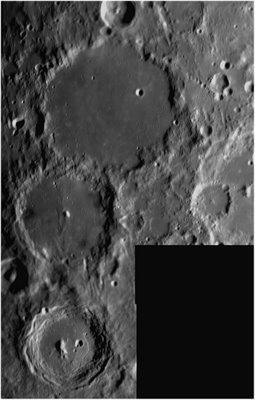 Ptolemaeus is an ancient lunar impact crater close to the center of the near side. To the south-southeast Ptolemaeus is joined to the rim of Alphonsus crater by a section of rugged, irregular terrain, and these form a prominent chain with Arzachel to the south. To the southeast is Albategnius crater and to the north is the smaller but well-defined Herschel crater.
Ptolemaeus is an ancient lunar impact crater close to the center of the near side. To the south-southeast Ptolemaeus is joined to the rim of Alphonsus crater by a section of rugged, irregular terrain, and these form a prominent chain with Arzachel to the south. To the southeast is Albategnius crater and to the north is the smaller but well-defined Herschel crater.The features of Ptolemaeus are highlighted when the sun is at low angles during the first and last quarter. During the full moon the sun is directly overhead and the crater contours become more difficult to discern.
The crater has a low, irregular outer rim that is heavily worn and impacted with multiple smaller craters. The rim has a discernable polygonal shape, although overall it remains circular. The largest of the peaks along the rim, designated Ptolemaeus Gamma (γ), has an altitude of 2.9km and is located along the northwest rim. The crater has no central peak, a lava-flooded floor, and lacks a ray system. Impact sites of this form are often classified as a "walled-plain", due to their resemblance to the maria.
The somewhat dark-hued floor of Ptolemaeus is notable for several "ghost" craters, formed when lava flow covers a pre-existing crater. These leave only a slight rise where the rim existed, and are difficult to detect except at low angles of sunlight. There are also multiple smaller craters across the floor surface, most notably Ammonius crater in the northeastern quadrant.
On either of this crater are a linear, irregular gashes in the lunar surface, forming valley-like features. These features are approximately parallel to each other and radiate from the direction of Mare Imbrium to the north-northwest.
Wikipedia
 Here's a great view by Apollo 12, taken on the right of the crater, looking across it to the West.
Here's a great view by Apollo 12, taken on the right of the crater, looking across it to the West.

